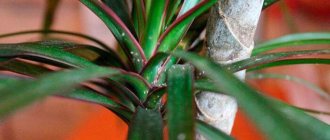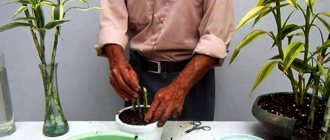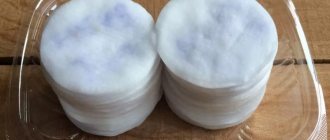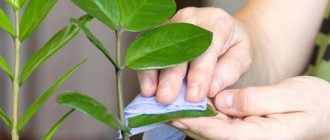All types of dracaenas are ideal plants for home keeping . They are able to grow both on bright south-eastern window sills and in the back of the room under artificial light. They also have no special requirements for soil composition and room humidity.
Most species of these palms grow very tall in nature. As they grow, the lower leaves age and fall off, the stem gradually becomes bare and the plant loses its decorative appearance. Therefore, pruning of dracaena is necessary to obtain side shoots.
Photo gallery
Formation of dracaena. Filling the cut with paraffin.
It is unpretentious in care; the only aspect that can cause difficulties when growing it is pruning, which must be done regularly.
What problems may arise
Dracaena is an unpretentious crop, but there are several rules, the observance of which will help keep the flower beautiful and healthy and will not lead to its premature death:
- moderate watering, the soil should be slightly moist. The flower easily tolerates drought;
- When replanting a flower, use only new (disposable) pots. The use of used containers increases the likelihood of contracting any infection;
- wean the flower from the greenhouse in time.
Important! Dracaena is a succulent plant. Excessive watering can lead to its death.
Dracaena is a universal decorative flower that will be appropriate in any room, creating a unique atmosphere. By giving the plant an original shape, you can further emphasize its tropical origin and enjoy its exotic appearance for many years.
Why do you prune dracaena?
There are three main reasons why dracaena is pruned:
- sanitary and preventive, in which all damaged leaves and shoots are cut off to stop the spread of the disease;
- decorative, in which a crown is formed;
- if the dracaena has grown to the ceiling.
To obtain side shoots and rejuvenate dracaena, decorative pruning is also used, giving the plant a well-groomed appearance and the necessary splendor. In addition, pruning is used as one of the methods of propagating dracaena, the cuttings of which take root quite quickly and successfully.
Trimming time
The dracaena stem is a structure in which dormant buds are arranged in a spiral along its entire length. This is what makes it possible to obtain seedlings and the beginnings of new branches from a cut made in any part of the trunk.
Planned pruning of dracaena is done during the active growth period, when sap flow is best. There are times when the formation of a bush is needed urgently. For example, part of the stem broke off. Then the shortening must be carried out according to the rules, below the break point. Any pruning can only be effective on a healthy plant.
How to prune dracaena correctly at home?
First of all, you need to understand what height of tree you want to get in the end. The second important factor is lighting, because future shoots will develop precisely due to the light falling on them.
The cut should be at such a level that new shoots and foliage receive sufficient sunlight.
Expert opinion
Mokhov Andrey Petrovich
Graduated from KubSAU, specialty: agronomy
It is recommended to prune dracaena at a distance of at least 30 cm from the surface of the ground, with the exception of sanitary pruning if necessary or trimming an elongated stem.
To carry out the pruning procedure, you can use a scalpel or a sharp sterile knife; it is not recommended to use scissors or garden pruners, as they pinch the stem and can cause unwanted damage.
You will also need garden pitch or a more conventional paraffin candle, sphagnum moss, a water sprayer and a plastic bag.
What types of dracaena need to be pruned?
At home, as a rule, the following types and varieties of dracaena are grown:
- Reflexa or Dracaena recurta. It has long, pointed leaves with striped colors ranging from dark green to yellow and beige. It has a thick stem that grows at home up to a meter in height.
- Surculosa or Dracaena shoot-bearing. The leaves are bright green, round in shape, with a pointed end and an unusual spotted color. The trunk often branches, new shoots quickly grow, turning the dracaena into a voluminous fluffy bush.
- Fragrans or Dracaena Fragrant. The leaves are long, glossy up to half a meter in length, and have a characteristic dark green color with light stripes. It can bloom at home, which explains its name.
- Marginata or Madagascar dragon tree. It is this species that is most often found and associated with the palm tree, due to the characteristic shape of the trunk and crown. The leaves are thin and long, of various shades of green from light green to completely dark, with a light or reddish border along the edge.
All types of dracaena grown at home need pruning; only its frequency differs.
Trimming time
Like all procedures that injure the plant, pruning must be carried out during the period of active growth, this is the only way to guarantee that everything will be successful and the dracaena will quickly recover. This period can be considered the time from the end of winter to the beginning of summer. The optimal months are April and May.
You should not prune immediately after transplantation, as the plant may not withstand double stress. It is best to wait at least a month. During this time, the dracaena will successfully take root in the new pot and will survive the operation much easier.
In the autumn-winter period, pruning is not recommended, since low temperatures and lack of light can lead to the fact that it will take more than one month for new buds to appear; in the worst case, the plant may even die.
To increase the dracaena's chances of survival, it is necessary to provide it with the most comfortable conditions possible and maintain them throughout the period it takes for new shoots to appear.
Step-by-step instructions for crown formation
When faced with the need to prune dracaena, in order to achieve results and not destroy the plant, it is important to strictly follow the algorithm of actions:
- Determine the height of the cut and mark this place.
- Using a sharp knife, cut off the top along the mark line. Under no circumstances should shoots be broken off.
- Using a piece of cotton wool, remove the juice that appears at the cut site, then fill the top of the stem with garden varnish or paraffin. It is not recommended to use wax for this purpose, since its melting point is much higher than that of paraffin. This will only harm the plant.
- If there are leaves on the trunk, they must be removed from the entire area 10–15 cm below the cut.
- Spray generously with water and wrap the section of the trunk below the cut with damp sphagnum, leaving the cut itself open.
- Place a transparent plastic bag or film on top to maintain the required temperature and humidity.
Expert opinion
Mokhov Andrey Petrovich
Graduated from KubSAU, specialty: agronomy
For the trimmed top, you can prepare a separate pot, planting it in which, after a while you can get another plant.
Over the next month, new shoots will appear on the trunk; until this time, it is recommended to remove the plastic bag no more than once every 5 days to ventilate and spray the plant.
What to do with cut shoots?
When pruning dracaena, we are left with shoots. Which can be used when propagating dracaena. There are two ways to root shoots:
- the first is to simply put the shoots in a container of water and wait until they take root. With such rooting, we change the water in the container every day; dracaena shoots tend to fade in water. As soon as the shoots give roots, they can be planted in separate pots, using ordinary soil for indoor plants.
- the second is to cut the shoot into an equal number of pieces (no more than 5-10cm) and they take root in the soil. The soil will consist of a mixture of peat and sand. As soon as the cuttings take root, we transplant them into separate containers.
Plant varieties
Dracaena is an evergreen shrub belonging to the Agave genus. Each variety has its own characteristics for care and pruning. The most popular types:
| Photo | Description |
| The largest type for apartment maintenance. The plant has drooping, curved leaves of variegated color. Grows in height up to 5 meters. Therefore, it is better to grow in rooms with high ceilings. Caring for a plant is complex and requires certain skills. |
| The bush is branched, small in size. As the plant grows, it forms several stems that emerge directly from the root system. The leaf blade is elongated and curved, painted a bright olive color with yellow stripes. This variety does not require formative pruning. |
| A medium-sized plant with spotted dark green leaves. This species requires regular pruning to achieve a beautiful appearance. New shoots are periodically formed, and without pruning the crown of the tree loses its attractive appearance |
| A large tree with a strong woody trunk. Dark olive, wide leaves have pronounced lemon or snow-white stripes |
| An attractive, but rather difficult to care for look that is loved by many gardeners. Wide round leaves are transversely colored with white-olive stripes |
Treatment of the cut area
There are different approaches to treating a wound after a cut:
- Some gardeners advise not to treat the cut area with anything, water the soil in the pot and cover it with a jar or film. Then place the flower in a sunny place, away from direct rays, and water it in a tray without opening the trunk. In a month and a half, young shoots will appear on the flower. But for this it is necessary that the temperature inside the shelter be 20-25°C and the humidity about 75%.
- Others argue that the cut site must be treated so that it does not fester. To do this, use crushed charcoal, sprinkling it on the cut area. You can fill it with melted paraffin. When it cools, it will become hard and will protect against the penetration of pathogens. Sometimes they are treated with special wax to treat the cut area.
Further care
The plant is placed in a warm room where the air temperature does not drop below +20 degrees. If pruning is carried out in winter, additional artificial lighting is installed above the crop. The flower is protected from drafts; temperature changes can quickly destroy it.
3-4 days after pruning, the plant is fed with nitrogenous fertilizers to awaken the buds. Fertilizing is carried out after abundant watering. To do this, you can use ammonium nitrate (1 tsp per 3 liters of water).
Fertilizer is administered once every 14 days for 3 months until the side shoots grow to 6 cm in length. Watering is carried out as the soil dries with warm, settled water. Since the palm tree prefers high humidity, the trunk is sprayed once every 7 days. To ensure uniform fouling of the crown, the pot with the plant is periodically turned towards the light.










